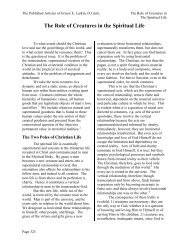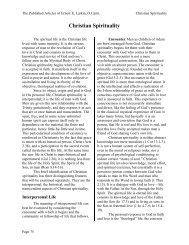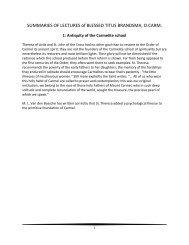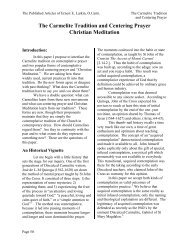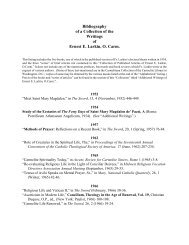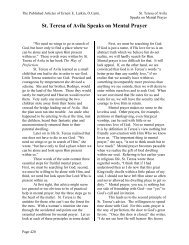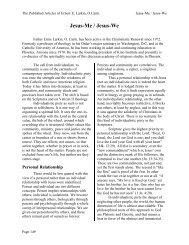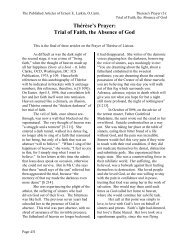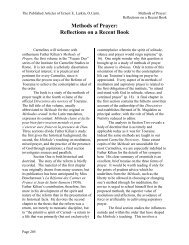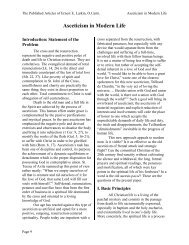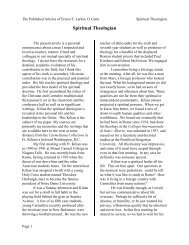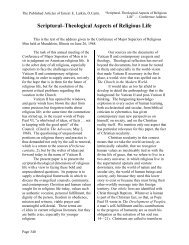Religious Life and Vatican II - Carmelnet
Religious Life and Vatican II - Carmelnet
Religious Life and Vatican II - Carmelnet
You also want an ePaper? Increase the reach of your titles
YUMPU automatically turns print PDFs into web optimized ePapers that Google loves.
The Published Articles of Ernest E. Larkin, O.Carm. <strong>Religious</strong> <strong>Life</strong> <strong>and</strong> <strong>Vatican</strong> <strong>II</strong><br />
Page 298<br />
<strong>Religious</strong> <strong>Life</strong> <strong>and</strong> <strong>Vatican</strong> <strong>II</strong><br />
This article was originally given as a speech at the annual meeting of the Midwest <strong>Religious</strong><br />
Vocation Directors’ Association in North Aurora, Illinois, September 18, 1965.<br />
Introduction<br />
The topic assigned to me is the reevaluation<br />
of religious life in the light of the<br />
Conciliar decrees. I shall first list the decrees<br />
in question, then point out some areas of reevaluation.<br />
Of the decrees so far published,<br />
Chapter VI of the Constitution on the Church<br />
is the most important for our consideration. It<br />
originated in discussions on the states of<br />
perfection in the Church. The Council Fathers<br />
found the categories of states of perfection<br />
unacceptable <strong>and</strong> the doctrine of holiness in<br />
the Church was rewritten in terms of the<br />
universal call to Christian perfection. But<br />
neither was this unilateral consideration<br />
enough. After 250 interventions that ran to<br />
1,000 pages, the Council accepted two<br />
chapters on the matter. One was Chapter V on<br />
Christian holiness as the vocation of every<br />
member in the Church; the other, Chapter VI<br />
on religious life. Chapter V is a magnificent<br />
statement of the basic elements of Christian<br />
holiness. Holiness is the same for all, founded<br />
on hearing <strong>and</strong> keeping the Word of God,<br />
expressing itself in the Sacraments <strong>and</strong> prayer,<br />
self-denial <strong>and</strong> brotherly concern; Chapter VI<br />
shows how the vows deepen this Baptismal<br />
commitment. <strong>Religious</strong> life is thus presented<br />
in the Council dogmatically rather than<br />
canonically. The category “ state of<br />
perfection” is by-passed <strong>and</strong> the emphasis<br />
shifted from the juridic to the vital reality of<br />
grace <strong>and</strong> charity.<br />
Is the Council’s procedure here a<br />
downgrading of religious life? I do not think<br />
so; it is merely a different way of speaking<br />
<strong>and</strong> a shift of emphasis. First, a different way<br />
of speaking. It is a truism that today the<br />
subjective, the personal, the experienced are<br />
synonymous with the real. For this reason<br />
objective categories as such which are abstract<br />
<strong>and</strong> theoretic seem to be unreal <strong>and</strong> irrelevant.<br />
Just as doctors say there are no sicknesses,<br />
only sick people, so there is no perfection or<br />
state of perfection, only people who are more<br />
or less perfect. Perfection is a subjective<br />
matter, your answer to your call. For this<br />
reason some authors refuse to speak about<br />
objective states of perfection because the only<br />
norm is the particular vocation. The council<br />
has spoken along this line. It does not deny, it<br />
prescinds. from the scholastic doctrine of<br />
states of perfection. Secondly, there is a<br />
change of emphasis in the council’s attitude.<br />
The Constitution, while not lyrical, is positive<br />
in its praise of religious life <strong>and</strong> uses adverbs<br />
like pressius (42;44) <strong>and</strong> singulariter (42;43)<br />
to characterize the imitation of Christ <strong>and</strong> way<br />
of perfection in religious life.<br />
To remove any doubt in the matter,<br />
Pope Paul VI reasserted in strong terms the<br />
intrinsic superiority of religious life in his<br />
allocution to the capitulars of five or six<br />
orders on May 24, 1964. We consider this<br />
document a second important source for our<br />
topic. It is not strictly a conciliar document,<br />
but like the Pope’s Ecclesiam suam in<br />
reference to the Constitution on the Church,<br />
this allocution actually interprets the Council’s<br />
words about religious life.<br />
We await what could be the most<br />
important document for our purpose, the<br />
schema on religious renewal, which remains<br />
to be approved <strong>and</strong> published in the Council.<br />
This schema is important even in its present<br />
unapproved forms. The last available revision<br />
(1964) is entitled “Renewal Adapted to<br />
<strong>Religious</strong> <strong>Life</strong>,” (De accommodata
The Published Articles of Ernest E. Larkin, O.Carm. <strong>Religious</strong> <strong>Life</strong> <strong>and</strong> <strong>Vatican</strong> <strong>II</strong><br />
renovatione vitae religiosa.) Originally it was<br />
called “The State of Acquiring Perfection,”<br />
(1962), then simply “<strong>Religious</strong>” (1963), <strong>and</strong> in<br />
the last session it received its present<br />
designation. The document has shrunk from<br />
an original 130 pages in 1962 to four pages in<br />
1964. It has been totally rewritten at least<br />
twice by the conciliar committee <strong>and</strong> was<br />
returned to committee last October for a final<br />
revision. What will come out of the final<br />
session is anybody’s guess, but presumably it<br />
will follow the lines of the 1964 version. This<br />
formulation was general enough, too general<br />
according to many, especially in its failure to<br />
set up machinery to apply the norms it laid<br />
down for renewal. But it did sum up many of<br />
the principles of adaptation discussed in the<br />
international congress of religious in 1950 <strong>and</strong><br />
in subsequent national conferences.<br />
Other decrees of <strong>Vatican</strong> <strong>II</strong> already<br />
published have relevance for the re-evaluation<br />
of religious life according to their subject<br />
matter. The Constitution on the Liturgy is<br />
supremely important. So is the decree on<br />
ecumenism. It is a sad fact that orders have<br />
not distinguished themselves as communities<br />
in leadership or even participation in the<br />
biblical, liturgical, social <strong>and</strong> ecumenical<br />
movements in the Church today. Council<br />
Fathers like Cardinal Doepfner of Munich<br />
have complained that the religious orders have<br />
been slow in applying themselves to these<br />
movements. Renewal is a look into the past, to<br />
one’s origins, it is true, but it is also a listening<br />
to the Holy Spirit in the present moment of<br />
salvation history. For a religious community<br />
to neglect the decree on the liturgy <strong>and</strong> its<br />
biblical orientations would be a capital sin.<br />
Father Tavard argues convincingly that a<br />
renewal in the liturgy would bring a renewal<br />
of religious life <strong>and</strong> the solution of many of<br />
the tensions <strong>and</strong> ills afflicting religious life<br />
today. Both liturgy <strong>and</strong> religious life are<br />
anticipated celebrations of the final<br />
eschatological state of the Church in signs.<br />
Page 299<br />
This completes the survey of the<br />
documents. What do they tell us of the mind<br />
of the Church on religious life today? We<br />
single out four main areas for comment:<br />
concept of religious life itself, community life,<br />
the vows <strong>and</strong> the apostolate.<br />
<strong>Religious</strong> <strong>Life</strong><br />
The Council defines religious life in<br />
the Constitution on the Church as a service, a<br />
witness <strong>and</strong> an apostolate. While it sees this<br />
form of life as total consecration to God, the<br />
perspective is the salvific mission of the<br />
Church rather than exclusively personal<br />
sanctification. The Council thus gets away<br />
from the concept of individualistic striving<br />
after perfection. <strong>Religious</strong> life is for the whole<br />
Mystical Body. It is a charism, a spiritual gift,<br />
arising in the Church from below, but<br />
regulated from above. While religious life<br />
does not pertain to the hierarchical structure of<br />
the Church, it is essential to the Church,<br />
because it is the expression of the pure faith<br />
<strong>and</strong> charity of the Church in their transcendent<br />
reality. <strong>Religious</strong> life thus pertains to the order<br />
of holiness received <strong>and</strong> lived; however active<br />
<strong>and</strong> apostolic it seems it is not part of the<br />
hierarchical function of teaching, ruling <strong>and</strong><br />
sanctifying.<br />
Here we touch on something new:<br />
religious are no longer a special class in the<br />
Church, because there are only two classes,<br />
clergy <strong>and</strong> laity. The Code of Canon Law has<br />
a triple division of clergy, religious <strong>and</strong> laity;<br />
the Constitution rejects this division <strong>and</strong><br />
makes the religious vocation a personal <strong>and</strong><br />
social expression of sanctity in the Mystical<br />
Body. The vocation of religious is to be holy,<br />
to mirror the life of Christ. Each order<br />
represents different aspects, some active, some<br />
contemplative. So in the words of the Council<br />
the orders represent “Christ contemplating on<br />
the mountain, announcing the kingdom of God<br />
to the crowds, healing the sick <strong>and</strong> the<br />
maimed, converting sinners to the better life,<br />
blessing children, helping all.” (n. 46). As
The Published Articles of Ernest E. Larkin, O.Carm. <strong>Religious</strong> <strong>Life</strong> <strong>and</strong> <strong>Vatican</strong> <strong>II</strong><br />
witness, therefore, all religious life,<br />
contemplative as well as active, is intrinsically<br />
apostolic. The schema on renewal has stressed<br />
this point. Unfortunately the schema does not<br />
define active <strong>and</strong> contemplative life, nor does<br />
it distinguish active religious priests from<br />
secular priests. This leaves open a host of<br />
questions like the role of monasticism in our<br />
world, the relationship between priesthood<br />
<strong>and</strong> religious life in clerical institutes, <strong>and</strong> the<br />
nature of active spirituality.<br />
Both the schema <strong>and</strong> Pope Paul VI’s<br />
allocution make it clear that religious life is an<br />
eschatological state, a life of charity <strong>and</strong><br />
adoration based on the rejection of the worldly<br />
goods of property family, <strong>and</strong> selfdetermination.<br />
The priesthood, on the other<br />
h<strong>and</strong>, is a functional ministry, ordered to<br />
constituting <strong>and</strong> building up the Body of<br />
Christ, especially through the bread of the<br />
Eucharist <strong>and</strong> the word of God. <strong>Religious</strong> life<br />
<strong>and</strong> priesthood, therefore, are different orders<br />
of reality. They can be united in the same<br />
persons precisely because they are different<br />
formalities; but by the same token their<br />
presence together creates some tensions in the<br />
religious priest.<br />
None of this is very new to anyone<br />
who is familiar with the modern theology of<br />
religious life. For a number of years the better<br />
writers have been presenting religious life in a<br />
doctrinal <strong>and</strong> historical perspective that is<br />
theological rather than canonical. <strong>Religious</strong><br />
life has been conceived in terms of the great<br />
evangelical truths of Christian life. We have<br />
learned not to think of the vows in a negative<br />
fashion, with no relation to faith <strong>and</strong> charity.<br />
The theological virtues are the reason for the<br />
counsels. The affirmations of the Council<br />
approve this way of thinking <strong>and</strong> prevent our<br />
mistaking the accidental for the essential in<br />
religious life. This point of view also keeps us<br />
from looking down on other forms of<br />
Christian perfection, like that of the secular<br />
priest or the layman in the world. The secular<br />
Page 300<br />
priest’s way is not a second-rate way to God,<br />
nor is religious life the only way to perfection.<br />
Community <strong>Life</strong><br />
Perhaps the single most discussed<br />
point about religious life today is community<br />
life. Renewal is a return from this point of<br />
view. <strong>Religious</strong> life must see itself as the<br />
“apostolic life” wherein “with one heart <strong>and</strong><br />
one soul... they had all things in common.”<br />
(Acts 4: 32). The Acts of the Apostles describe<br />
this apostolic life which harkens back to the<br />
life of the Apostles with the Lord in the<br />
Gospels. The primitive Church endeavored to<br />
reproduce the evangelical life. Possessing<br />
things in common was a mere sign of spiritual<br />
union with one another. The essence of<br />
apostolic life was communal charity.<br />
Community life, therefore, is the very heart of<br />
religious life. But how can we achieve a sense<br />
of community in the face of the instability, the<br />
mobility <strong>and</strong> the enormous dem<strong>and</strong>s made on<br />
religious in the active life today? The answer<br />
seems to be the cultivation of community<br />
spirit (fraterna associatio n. 43). <strong>Religious</strong> life<br />
is not exclusively a withdrawal, much less a<br />
refusal of the world; it is a life of perfect<br />
charity, fraternal charity among Christians<br />
subject to their Lord. Community cannot mean<br />
only that everyone is doing the same thing at<br />
the same time. This uniformity is often<br />
impossible. But in the absence of material<br />
conformity <strong>and</strong> in the hectic hyperactive lives<br />
of most modern religious, other means must<br />
compensate for developing the essential<br />
brotherly union. Such means today are<br />
dialogue, concern <strong>and</strong> interest in one’s<br />
brothers, <strong>and</strong> group meetings which would be<br />
the modern equivalent of the collationes of the<br />
Desert Fathers.<br />
The Vows<br />
<strong>Vatican</strong> <strong>II</strong> repeats the classical doctrine<br />
that the vows remove obstacles to Christian<br />
perfection. Obedience, for example, according<br />
to the 1964 schema <strong>and</strong> in words that repeat
The Published Articles of Ernest E. Larkin, O.Carm. <strong>Religious</strong> <strong>Life</strong> <strong>and</strong> <strong>Vatican</strong> <strong>II</strong><br />
Paul VI’s allocation of May 24, 1965, is a<br />
“holocaust of one’s will.” But <strong>Vatican</strong> <strong>II</strong> is<br />
also aware of the hazards of the vows, the<br />
danger that they might stunt a man’s<br />
emotional <strong>and</strong> even spiritual growth. To<br />
achieve spiritual freedom rather than<br />
dehumanize a man, the living of the vows<br />
must be authentic. Poverty, for example, must<br />
be real <strong>and</strong> not merely juridic. It is a<br />
declaration of freedom from material<br />
dependency <strong>and</strong> comforts <strong>and</strong> not the legal<br />
fiction of getting permission for one’s selfindulgence.<br />
Poverty must be social as well as<br />
private <strong>and</strong> personal. Obedience must not be<br />
unthinking, as if there were a certain magic in<br />
doing another’s will. Obedience is not as<br />
excuse for dependency, for infantile thinking<br />
that rejects responsibility. Superiors especially<br />
are charged by obedience to find the good <strong>and</strong><br />
true, <strong>and</strong> lead in such ways that do not<br />
infringe against the personal responsibility,<br />
the dignity, <strong>and</strong> the liberty of their subjects.<br />
Chastity involves a loving more, not a loving<br />
less, in regard to one’s fellow men. Concretely<br />
there are many problems here, which the<br />
general statements of the Constitution or the<br />
schema do not resolve, but at least some<br />
direction is given for the re-thinking of the<br />
evangelical counsels today.<br />
The Apostolate<br />
The final area touched on by the<br />
Council is the apostolate of religious life. The<br />
Council views religious life entirely from this<br />
perspective <strong>and</strong> defines religious life as a<br />
special service that religious life gives to God<br />
<strong>and</strong> one’s fellow men in the Mystical Body.<br />
This service is primarily witness. Even its<br />
external works witness the faith <strong>and</strong> love of<br />
Christ. But the external tasks too are important<br />
in themselves. Pius X<strong>II</strong> once remarked that the<br />
Church could not fulfill its mission without<br />
the work of religious. But concretely, what are<br />
the tasks of religious orders? The answer is<br />
the works the communities were founded to<br />
Page 301<br />
perform. Each community must remain<br />
faithful to the charism of its origin.<br />
This brings up two problems much<br />
discussed outside the Council <strong>and</strong> so far not<br />
proposed officially. The first concerns the<br />
question of active spirituality. The schema on<br />
the priesthood finds the sanctification of<br />
priests in their apostolic work. Is this true of<br />
<strong>Religious</strong> also? <strong>Religious</strong> want more unity in<br />
their lives. Council speakers, including<br />
Cardinal Spellman, cautioned against overemphasizing<br />
activity at the expense of the<br />
contemplative life. Admittedly there is always<br />
the danger of activism, but many observes as<br />
well as religious today hope that a better<br />
formula to relate prayer <strong>and</strong> action in their<br />
lives will be found than the old dichotomies.<br />
Such a formula, it seems, must come from a<br />
positive interpretation of the role of action.<br />
The second problem concerns the<br />
juridic status of religious in the diocese. While<br />
there has been some criticism of the<br />
exemption of religious orders <strong>and</strong> even the<br />
independence in the diocese of nonexempt<br />
pontifical institutes, there seems to be little<br />
likelihood that religious will lose their relative<br />
independence in the diocese. The legitimacy<br />
of this juridic status is ably defended by<br />
experts on the ground of the charismatic<br />
nature of religious life. <strong>Religious</strong> life<br />
originates in the charism of a founder <strong>and</strong> the<br />
Church owes it to itself to foster <strong>and</strong> protect<br />
<strong>and</strong> preserve that charism. This can best, be<br />
done by leaving the religious community to<br />
certain independence in the Church.<br />
Conclusion<br />
By way of summary, we might say that<br />
the trends of thinking in <strong>and</strong> after <strong>Vatican</strong> <strong>II</strong><br />
are toward greater realism, toward the social<br />
dimension, <strong>and</strong> toward decentralization. The<br />
first quality, realism, is exemplified in the<br />
rejection of the concept of the states of<br />
perfection. The ecclesial definition of<br />
religious life, which underlines the apostolic<br />
<strong>and</strong> caritative function of religious life in the
The Published Articles of Ernest E. Larkin, O.Carm. <strong>Religious</strong> <strong>Life</strong> <strong>and</strong> <strong>Vatican</strong> <strong>II</strong><br />
Body of Christ <strong>and</strong> veers away from the<br />
purely private <strong>and</strong> ascetical, exemplifies the<br />
social preoccupation. Decentralization, which<br />
is one of the most universal trends of <strong>Vatican</strong><br />
<strong>II</strong>, finds expression in suggestions that new<br />
forms of religious life be developed in<br />
Page 302<br />
emerging countries <strong>and</strong> the care that<br />
individual ways be preserved. We religious<br />
are grateful to <strong>Vatican</strong> <strong>II</strong> for offering<br />
guidelines on the actual role of religious life in<br />
the Mystical Body today.



